Business Law Report: Legal System and Business Activities
VerifiedAdded on 2021/01/03
|11
|4325
|465
Report
AI Summary
This report provides a comprehensive overview of business law in the UK, examining the different sources of law, including statutory law, common law, and equity law, and the role of the government in the law-making process. It evaluates the effectiveness of the UK legal system, focusing on the impact of company law, contract law, and employment law on business activities. The report identifies the differences between legislation, regulations, and standards and analyzes their potential impact on businesses. It also details the legal formation, management, and funding of various business organizations, assessing the pros and cons of each structure. Finally, it explores methods of resolving legal disputes and compares different sources of legal advice and support, providing a thorough analysis of the UK's business law framework. This document is contributed by a student to be published on the website Desklib. Desklib is a platform which provides all the necessary AI based study tools for students.
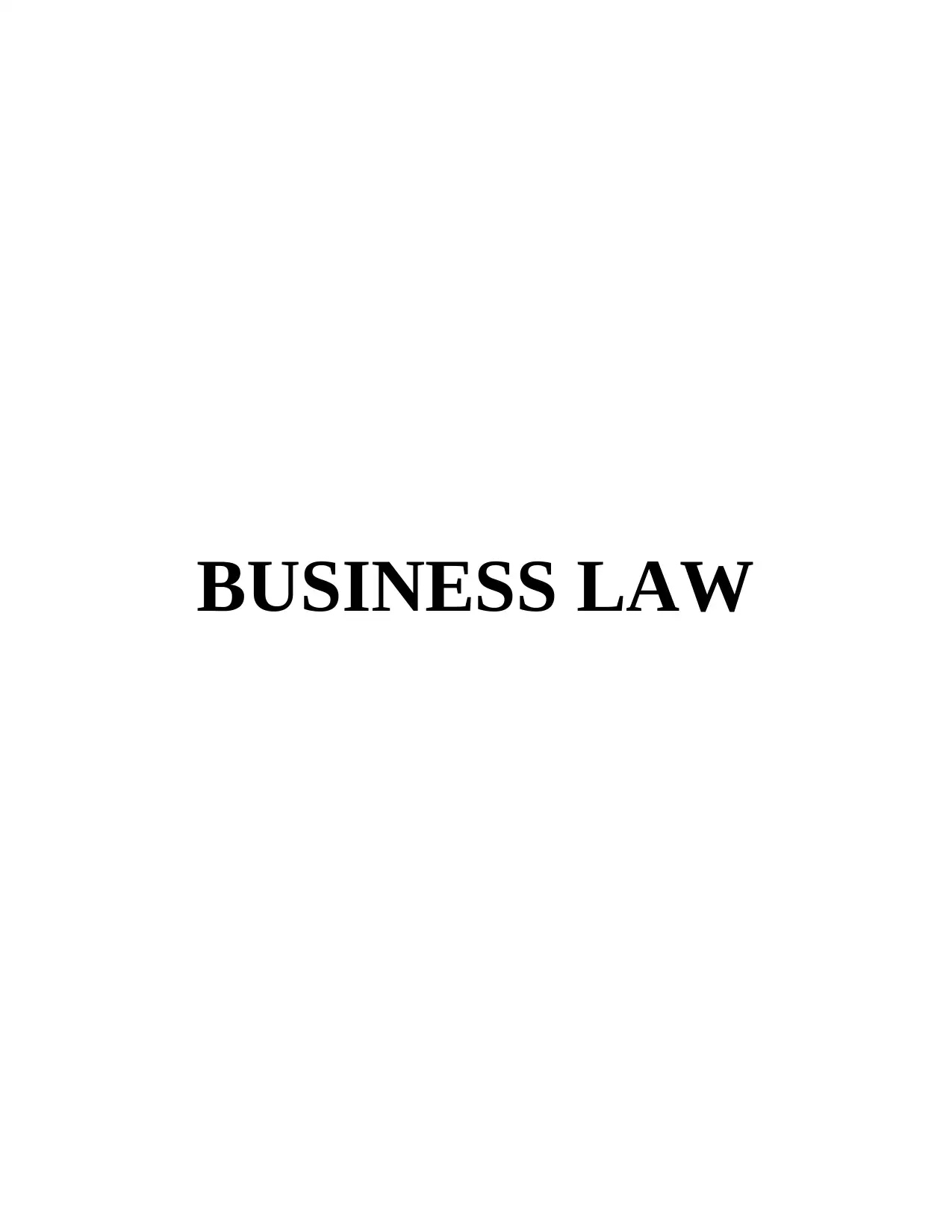
BUSINESS LAW
Paraphrase This Document
Need a fresh take? Get an instant paraphrase of this document with our AI Paraphraser
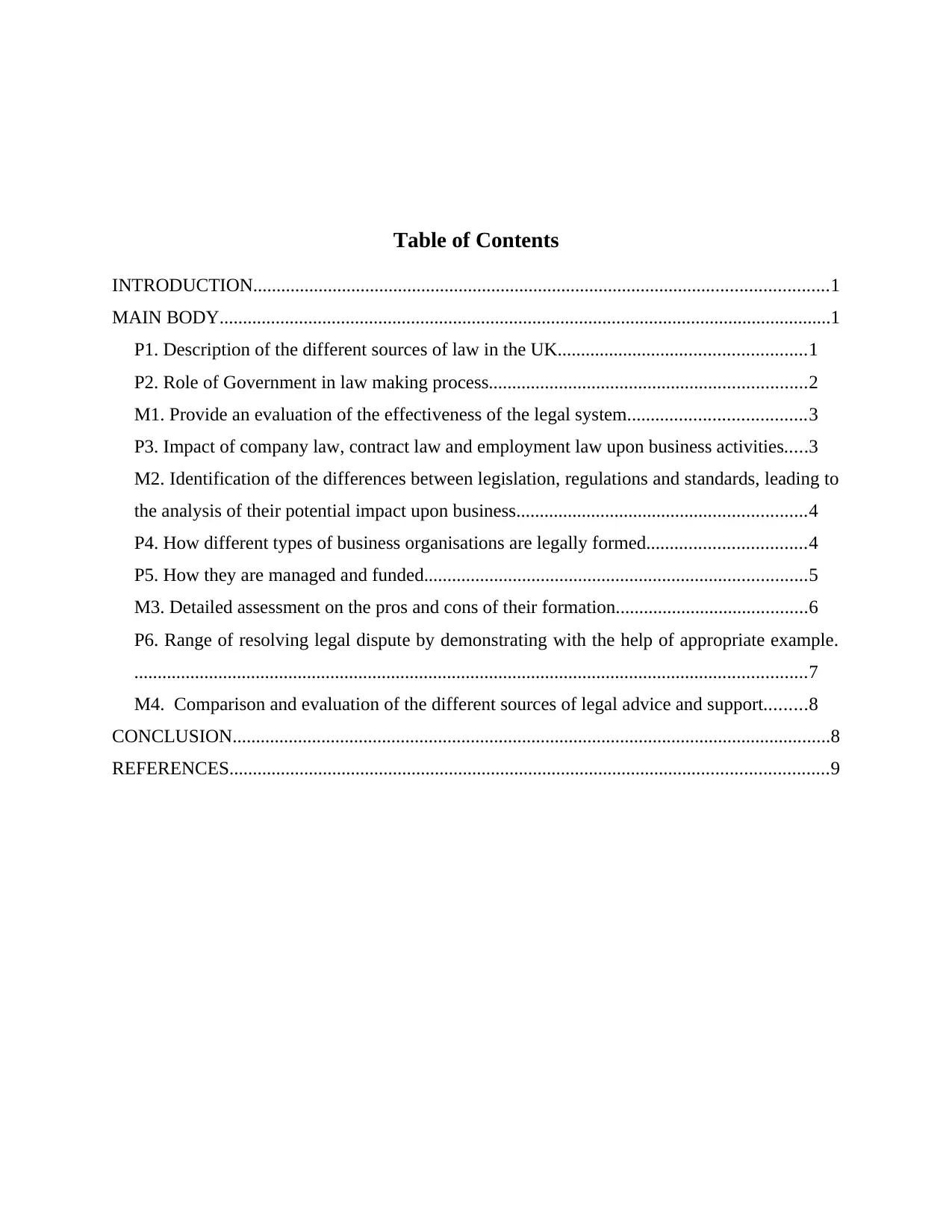
Table of Contents
INTRODUCTION...........................................................................................................................1
MAIN BODY...................................................................................................................................1
P1. Description of the different sources of law in the UK.....................................................1
P2. Role of Government in law making process....................................................................2
M1. Provide an evaluation of the effectiveness of the legal system......................................3
P3. Impact of company law, contract law and employment law upon business activities.....3
M2. Identification of the differences between legislation, regulations and standards, leading to
the analysis of their potential impact upon business..............................................................4
P4. How different types of business organisations are legally formed..................................4
P5. How they are managed and funded..................................................................................5
M3. Detailed assessment on the pros and cons of their formation.........................................6
P6. Range of resolving legal dispute by demonstrating with the help of appropriate example.
................................................................................................................................................7
M4. Comparison and evaluation of the different sources of legal advice and support.........8
CONCLUSION................................................................................................................................8
REFERENCES................................................................................................................................9
INTRODUCTION...........................................................................................................................1
MAIN BODY...................................................................................................................................1
P1. Description of the different sources of law in the UK.....................................................1
P2. Role of Government in law making process....................................................................2
M1. Provide an evaluation of the effectiveness of the legal system......................................3
P3. Impact of company law, contract law and employment law upon business activities.....3
M2. Identification of the differences between legislation, regulations and standards, leading to
the analysis of their potential impact upon business..............................................................4
P4. How different types of business organisations are legally formed..................................4
P5. How they are managed and funded..................................................................................5
M3. Detailed assessment on the pros and cons of their formation.........................................6
P6. Range of resolving legal dispute by demonstrating with the help of appropriate example.
................................................................................................................................................7
M4. Comparison and evaluation of the different sources of legal advice and support.........8
CONCLUSION................................................................................................................................8
REFERENCES................................................................................................................................9
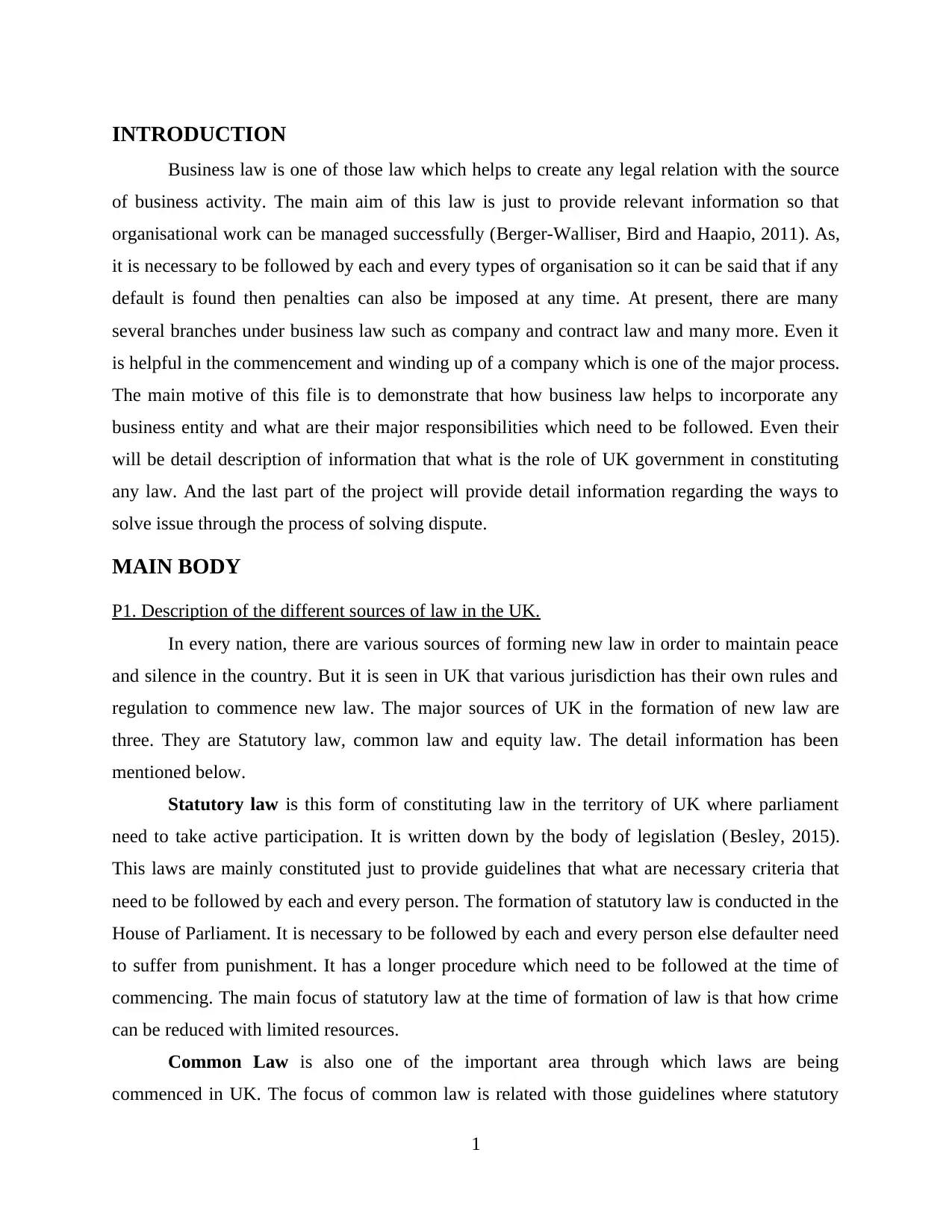
INTRODUCTION
Business law is one of those law which helps to create any legal relation with the source
of business activity. The main aim of this law is just to provide relevant information so that
organisational work can be managed successfully (Berger-Walliser, Bird and Haapio, 2011). As,
it is necessary to be followed by each and every types of organisation so it can be said that if any
default is found then penalties can also be imposed at any time. At present, there are many
several branches under business law such as company and contract law and many more. Even it
is helpful in the commencement and winding up of a company which is one of the major process.
The main motive of this file is to demonstrate that how business law helps to incorporate any
business entity and what are their major responsibilities which need to be followed. Even their
will be detail description of information that what is the role of UK government in constituting
any law. And the last part of the project will provide detail information regarding the ways to
solve issue through the process of solving dispute.
MAIN BODY
P1. Description of the different sources of law in the UK.
In every nation, there are various sources of forming new law in order to maintain peace
and silence in the country. But it is seen in UK that various jurisdiction has their own rules and
regulation to commence new law. The major sources of UK in the formation of new law are
three. They are Statutory law, common law and equity law. The detail information has been
mentioned below.
Statutory law is this form of constituting law in the territory of UK where parliament
need to take active participation. It is written down by the body of legislation (Besley, 2015).
This laws are mainly constituted just to provide guidelines that what are necessary criteria that
need to be followed by each and every person. The formation of statutory law is conducted in the
House of Parliament. It is necessary to be followed by each and every person else defaulter need
to suffer from punishment. It has a longer procedure which need to be followed at the time of
commencing. The main focus of statutory law at the time of formation of law is that how crime
can be reduced with limited resources.
Common Law is also one of the important area through which laws are being
commenced in UK. The focus of common law is related with those guidelines where statutory
1
Business law is one of those law which helps to create any legal relation with the source
of business activity. The main aim of this law is just to provide relevant information so that
organisational work can be managed successfully (Berger-Walliser, Bird and Haapio, 2011). As,
it is necessary to be followed by each and every types of organisation so it can be said that if any
default is found then penalties can also be imposed at any time. At present, there are many
several branches under business law such as company and contract law and many more. Even it
is helpful in the commencement and winding up of a company which is one of the major process.
The main motive of this file is to demonstrate that how business law helps to incorporate any
business entity and what are their major responsibilities which need to be followed. Even their
will be detail description of information that what is the role of UK government in constituting
any law. And the last part of the project will provide detail information regarding the ways to
solve issue through the process of solving dispute.
MAIN BODY
P1. Description of the different sources of law in the UK.
In every nation, there are various sources of forming new law in order to maintain peace
and silence in the country. But it is seen in UK that various jurisdiction has their own rules and
regulation to commence new law. The major sources of UK in the formation of new law are
three. They are Statutory law, common law and equity law. The detail information has been
mentioned below.
Statutory law is this form of constituting law in the territory of UK where parliament
need to take active participation. It is written down by the body of legislation (Besley, 2015).
This laws are mainly constituted just to provide guidelines that what are necessary criteria that
need to be followed by each and every person. The formation of statutory law is conducted in the
House of Parliament. It is necessary to be followed by each and every person else defaulter need
to suffer from punishment. It has a longer procedure which need to be followed at the time of
commencing. The main focus of statutory law at the time of formation of law is that how crime
can be reduced with limited resources.
Common Law is also one of the important area through which laws are being
commenced in UK. The focus of common law is related with those guidelines where statutory
1
⊘ This is a preview!⊘
Do you want full access?
Subscribe today to unlock all pages.

Trusted by 1+ million students worldwide
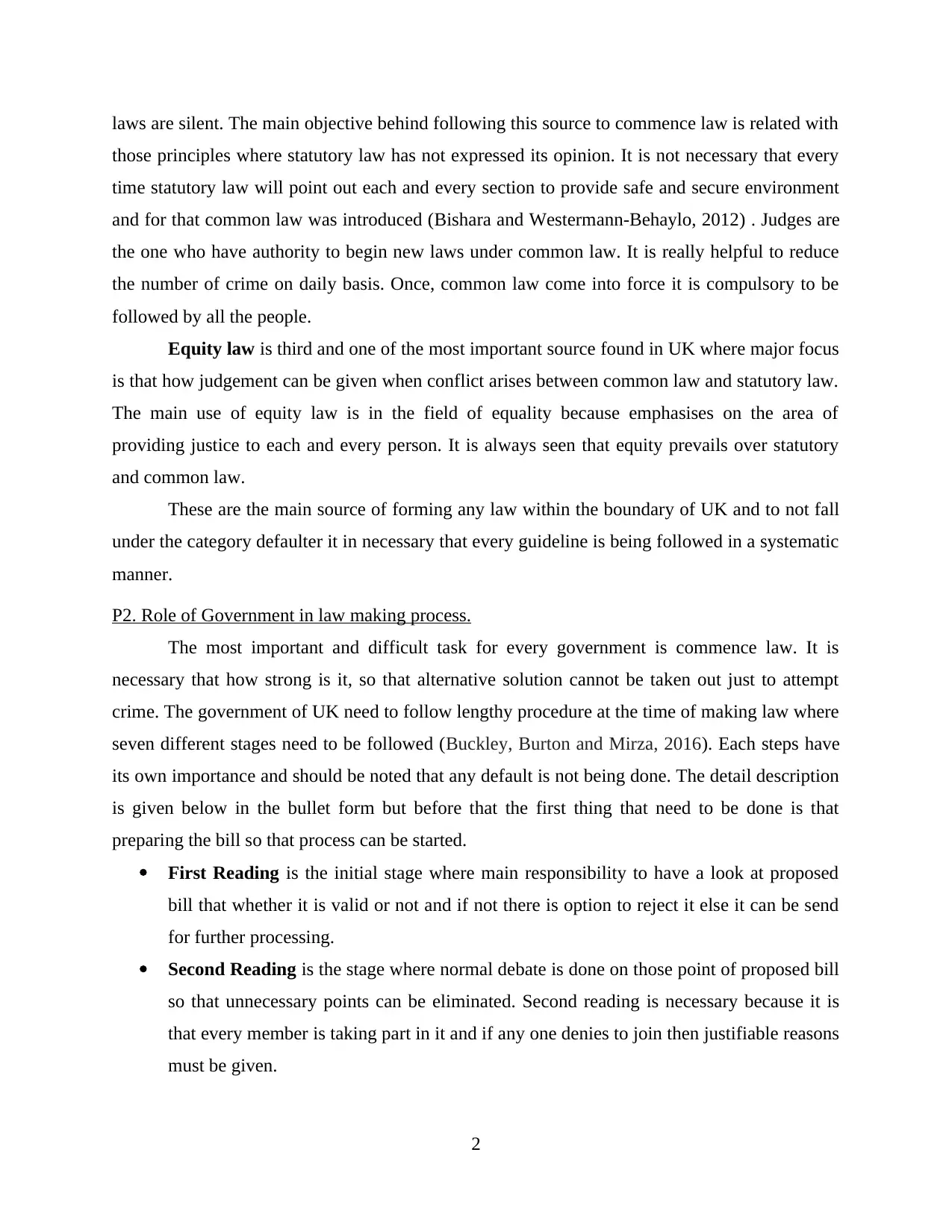
laws are silent. The main objective behind following this source to commence law is related with
those principles where statutory law has not expressed its opinion. It is not necessary that every
time statutory law will point out each and every section to provide safe and secure environment
and for that common law was introduced (Bishara and Westermann‐Behaylo, 2012) . Judges are
the one who have authority to begin new laws under common law. It is really helpful to reduce
the number of crime on daily basis. Once, common law come into force it is compulsory to be
followed by all the people.
Equity law is third and one of the most important source found in UK where major focus
is that how judgement can be given when conflict arises between common law and statutory law.
The main use of equity law is in the field of equality because emphasises on the area of
providing justice to each and every person. It is always seen that equity prevails over statutory
and common law.
These are the main source of forming any law within the boundary of UK and to not fall
under the category defaulter it in necessary that every guideline is being followed in a systematic
manner.
P2. Role of Government in law making process.
The most important and difficult task for every government is commence law. It is
necessary that how strong is it, so that alternative solution cannot be taken out just to attempt
crime. The government of UK need to follow lengthy procedure at the time of making law where
seven different stages need to be followed (Buckley, Burton and Mirza, 2016). Each steps have
its own importance and should be noted that any default is not being done. The detail description
is given below in the bullet form but before that the first thing that need to be done is that
preparing the bill so that process can be started.
First Reading is the initial stage where main responsibility to have a look at proposed
bill that whether it is valid or not and if not there is option to reject it else it can be send
for further processing.
Second Reading is the stage where normal debate is done on those point of proposed bill
so that unnecessary points can be eliminated. Second reading is necessary because it is
that every member is taking part in it and if any one denies to join then justifiable reasons
must be given.
2
those principles where statutory law has not expressed its opinion. It is not necessary that every
time statutory law will point out each and every section to provide safe and secure environment
and for that common law was introduced (Bishara and Westermann‐Behaylo, 2012) . Judges are
the one who have authority to begin new laws under common law. It is really helpful to reduce
the number of crime on daily basis. Once, common law come into force it is compulsory to be
followed by all the people.
Equity law is third and one of the most important source found in UK where major focus
is that how judgement can be given when conflict arises between common law and statutory law.
The main use of equity law is in the field of equality because emphasises on the area of
providing justice to each and every person. It is always seen that equity prevails over statutory
and common law.
These are the main source of forming any law within the boundary of UK and to not fall
under the category defaulter it in necessary that every guideline is being followed in a systematic
manner.
P2. Role of Government in law making process.
The most important and difficult task for every government is commence law. It is
necessary that how strong is it, so that alternative solution cannot be taken out just to attempt
crime. The government of UK need to follow lengthy procedure at the time of making law where
seven different stages need to be followed (Buckley, Burton and Mirza, 2016). Each steps have
its own importance and should be noted that any default is not being done. The detail description
is given below in the bullet form but before that the first thing that need to be done is that
preparing the bill so that process can be started.
First Reading is the initial stage where main responsibility to have a look at proposed
bill that whether it is valid or not and if not there is option to reject it else it can be send
for further processing.
Second Reading is the stage where normal debate is done on those point of proposed bill
so that unnecessary points can be eliminated. Second reading is necessary because it is
that every member is taking part in it and if any one denies to join then justifiable reasons
must be given.
2
Paraphrase This Document
Need a fresh take? Get an instant paraphrase of this document with our AI Paraphraser
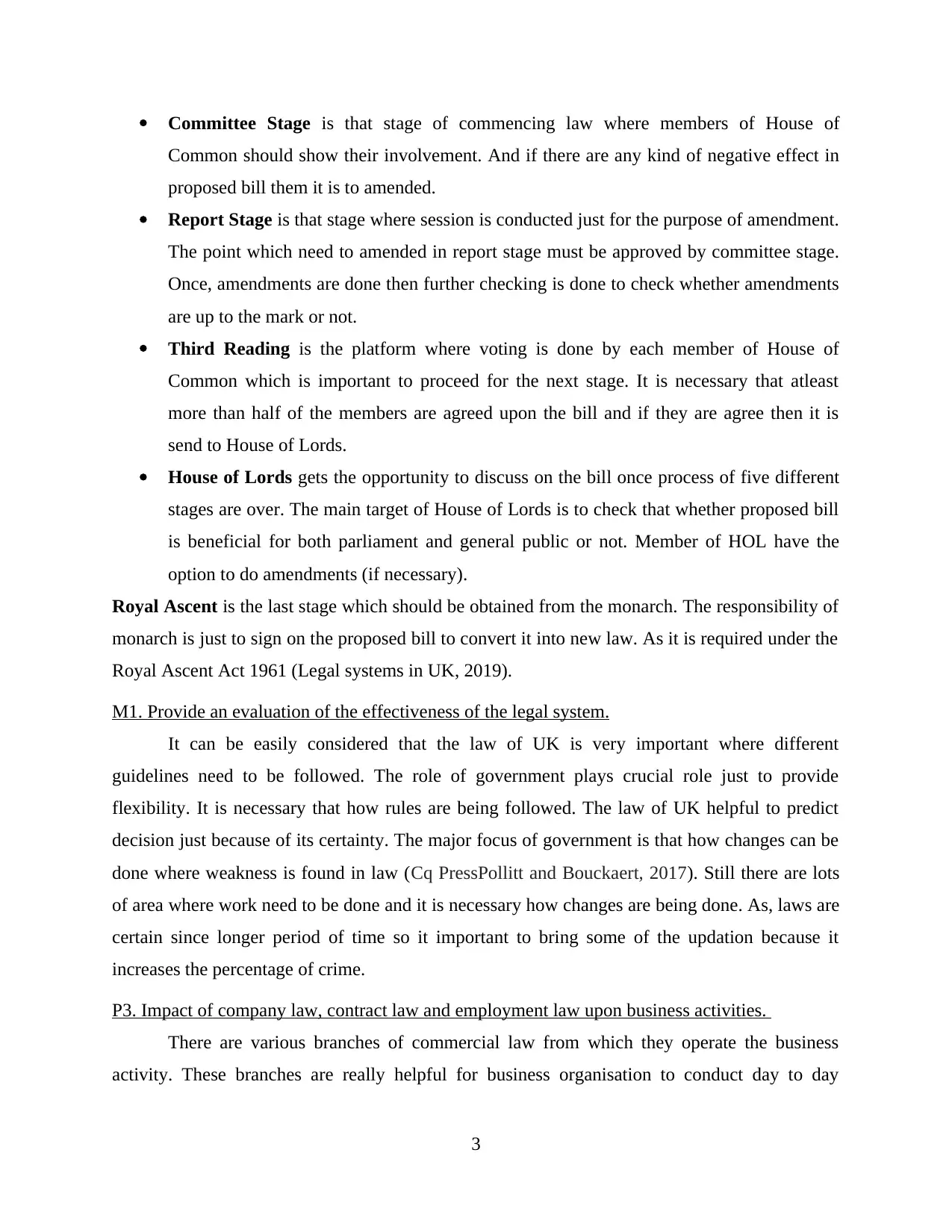
Committee Stage is that stage of commencing law where members of House of
Common should show their involvement. And if there are any kind of negative effect in
proposed bill them it is to amended.
Report Stage is that stage where session is conducted just for the purpose of amendment.
The point which need to amended in report stage must be approved by committee stage.
Once, amendments are done then further checking is done to check whether amendments
are up to the mark or not.
Third Reading is the platform where voting is done by each member of House of
Common which is important to proceed for the next stage. It is necessary that atleast
more than half of the members are agreed upon the bill and if they are agree then it is
send to House of Lords.
House of Lords gets the opportunity to discuss on the bill once process of five different
stages are over. The main target of House of Lords is to check that whether proposed bill
is beneficial for both parliament and general public or not. Member of HOL have the
option to do amendments (if necessary).
Royal Ascent is the last stage which should be obtained from the monarch. The responsibility of
monarch is just to sign on the proposed bill to convert it into new law. As it is required under the
Royal Ascent Act 1961 (Legal systems in UK, 2019).
M1. Provide an evaluation of the effectiveness of the legal system.
It can be easily considered that the law of UK is very important where different
guidelines need to be followed. The role of government plays crucial role just to provide
flexibility. It is necessary that how rules are being followed. The law of UK helpful to predict
decision just because of its certainty. The major focus of government is that how changes can be
done where weakness is found in law (Cq PressPollitt and Bouckaert, 2017). Still there are lots
of area where work need to be done and it is necessary how changes are being done. As, laws are
certain since longer period of time so it important to bring some of the updation because it
increases the percentage of crime.
P3. Impact of company law, contract law and employment law upon business activities.
There are various branches of commercial law from which they operate the business
activity. These branches are really helpful for business organisation to conduct day to day
3
Common should show their involvement. And if there are any kind of negative effect in
proposed bill them it is to amended.
Report Stage is that stage where session is conducted just for the purpose of amendment.
The point which need to amended in report stage must be approved by committee stage.
Once, amendments are done then further checking is done to check whether amendments
are up to the mark or not.
Third Reading is the platform where voting is done by each member of House of
Common which is important to proceed for the next stage. It is necessary that atleast
more than half of the members are agreed upon the bill and if they are agree then it is
send to House of Lords.
House of Lords gets the opportunity to discuss on the bill once process of five different
stages are over. The main target of House of Lords is to check that whether proposed bill
is beneficial for both parliament and general public or not. Member of HOL have the
option to do amendments (if necessary).
Royal Ascent is the last stage which should be obtained from the monarch. The responsibility of
monarch is just to sign on the proposed bill to convert it into new law. As it is required under the
Royal Ascent Act 1961 (Legal systems in UK, 2019).
M1. Provide an evaluation of the effectiveness of the legal system.
It can be easily considered that the law of UK is very important where different
guidelines need to be followed. The role of government plays crucial role just to provide
flexibility. It is necessary that how rules are being followed. The law of UK helpful to predict
decision just because of its certainty. The major focus of government is that how changes can be
done where weakness is found in law (Cq PressPollitt and Bouckaert, 2017). Still there are lots
of area where work need to be done and it is necessary how changes are being done. As, laws are
certain since longer period of time so it important to bring some of the updation because it
increases the percentage of crime.
P3. Impact of company law, contract law and employment law upon business activities.
There are various branches of commercial law from which they operate the business
activity. These branches are really helpful for business organisation to conduct day to day
3
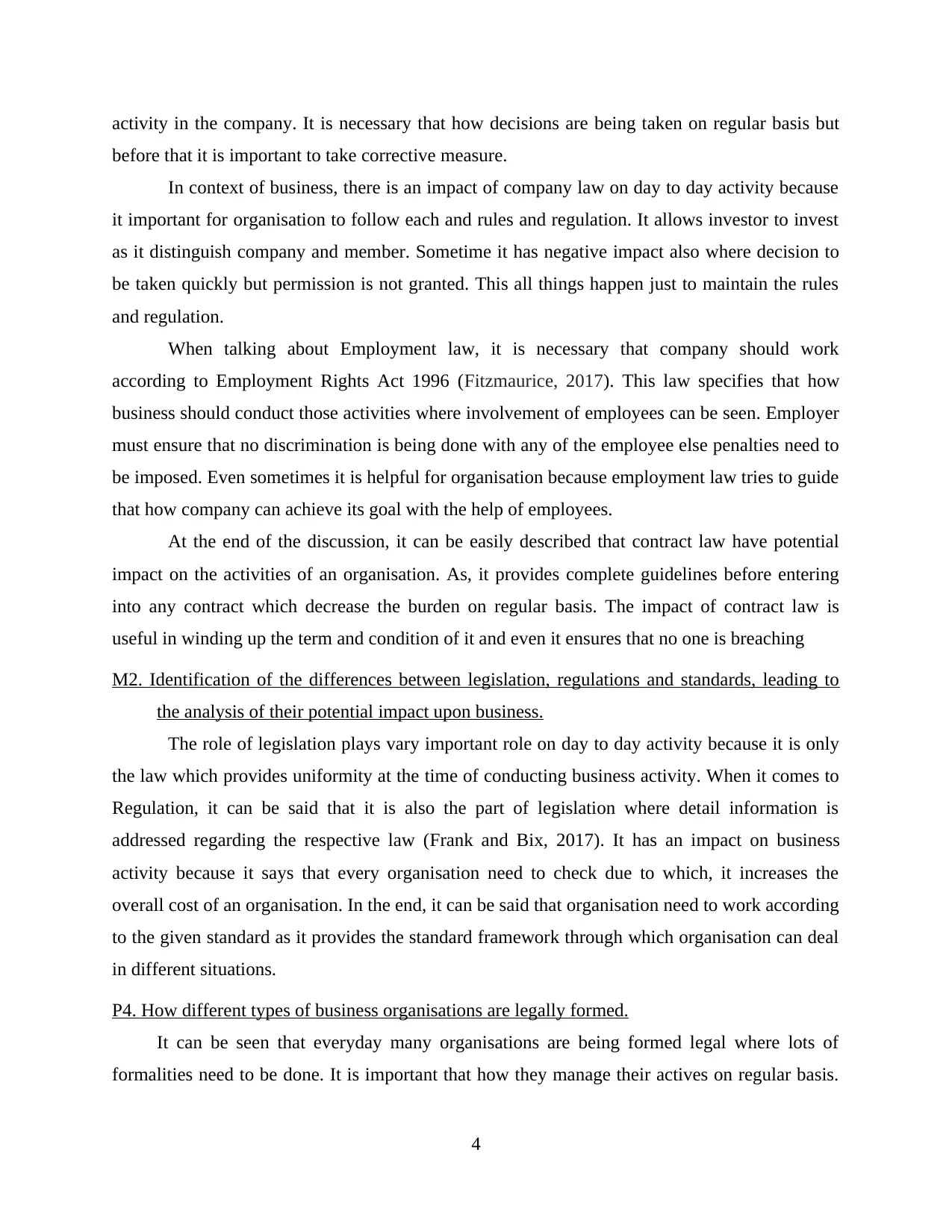
activity in the company. It is necessary that how decisions are being taken on regular basis but
before that it is important to take corrective measure.
In context of business, there is an impact of company law on day to day activity because
it important for organisation to follow each and rules and regulation. It allows investor to invest
as it distinguish company and member. Sometime it has negative impact also where decision to
be taken quickly but permission is not granted. This all things happen just to maintain the rules
and regulation.
When talking about Employment law, it is necessary that company should work
according to Employment Rights Act 1996 (Fitzmaurice, 2017). This law specifies that how
business should conduct those activities where involvement of employees can be seen. Employer
must ensure that no discrimination is being done with any of the employee else penalties need to
be imposed. Even sometimes it is helpful for organisation because employment law tries to guide
that how company can achieve its goal with the help of employees.
At the end of the discussion, it can be easily described that contract law have potential
impact on the activities of an organisation. As, it provides complete guidelines before entering
into any contract which decrease the burden on regular basis. The impact of contract law is
useful in winding up the term and condition of it and even it ensures that no one is breaching
M2. Identification of the differences between legislation, regulations and standards, leading to
the analysis of their potential impact upon business.
The role of legislation plays vary important role on day to day activity because it is only
the law which provides uniformity at the time of conducting business activity. When it comes to
Regulation, it can be said that it is also the part of legislation where detail information is
addressed regarding the respective law (Frank and Bix, 2017). It has an impact on business
activity because it says that every organisation need to check due to which, it increases the
overall cost of an organisation. In the end, it can be said that organisation need to work according
to the given standard as it provides the standard framework through which organisation can deal
in different situations.
P4. How different types of business organisations are legally formed.
It can be seen that everyday many organisations are being formed legal where lots of
formalities need to be done. It is important that how they manage their actives on regular basis.
4
before that it is important to take corrective measure.
In context of business, there is an impact of company law on day to day activity because
it important for organisation to follow each and rules and regulation. It allows investor to invest
as it distinguish company and member. Sometime it has negative impact also where decision to
be taken quickly but permission is not granted. This all things happen just to maintain the rules
and regulation.
When talking about Employment law, it is necessary that company should work
according to Employment Rights Act 1996 (Fitzmaurice, 2017). This law specifies that how
business should conduct those activities where involvement of employees can be seen. Employer
must ensure that no discrimination is being done with any of the employee else penalties need to
be imposed. Even sometimes it is helpful for organisation because employment law tries to guide
that how company can achieve its goal with the help of employees.
At the end of the discussion, it can be easily described that contract law have potential
impact on the activities of an organisation. As, it provides complete guidelines before entering
into any contract which decrease the burden on regular basis. The impact of contract law is
useful in winding up the term and condition of it and even it ensures that no one is breaching
M2. Identification of the differences between legislation, regulations and standards, leading to
the analysis of their potential impact upon business.
The role of legislation plays vary important role on day to day activity because it is only
the law which provides uniformity at the time of conducting business activity. When it comes to
Regulation, it can be said that it is also the part of legislation where detail information is
addressed regarding the respective law (Frank and Bix, 2017). It has an impact on business
activity because it says that every organisation need to check due to which, it increases the
overall cost of an organisation. In the end, it can be said that organisation need to work according
to the given standard as it provides the standard framework through which organisation can deal
in different situations.
P4. How different types of business organisations are legally formed.
It can be seen that everyday many organisations are being formed legal where lots of
formalities need to be done. It is important that how they manage their actives on regular basis.
4
⊘ This is a preview!⊘
Do you want full access?
Subscribe today to unlock all pages.

Trusted by 1+ million students worldwide
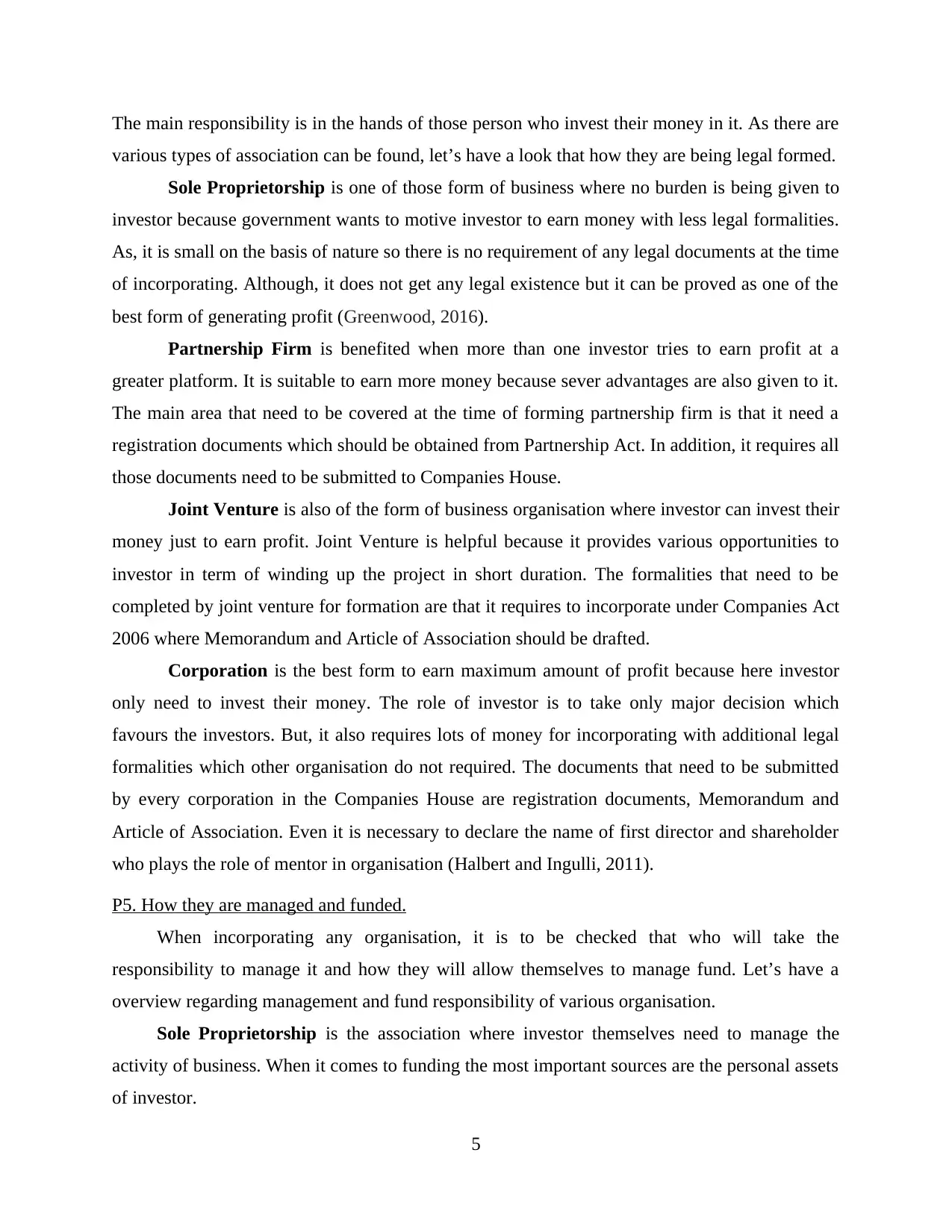
The main responsibility is in the hands of those person who invest their money in it. As there are
various types of association can be found, let’s have a look that how they are being legal formed.
Sole Proprietorship is one of those form of business where no burden is being given to
investor because government wants to motive investor to earn money with less legal formalities.
As, it is small on the basis of nature so there is no requirement of any legal documents at the time
of incorporating. Although, it does not get any legal existence but it can be proved as one of the
best form of generating profit (Greenwood, 2016).
Partnership Firm is benefited when more than one investor tries to earn profit at a
greater platform. It is suitable to earn more money because sever advantages are also given to it.
The main area that need to be covered at the time of forming partnership firm is that it need a
registration documents which should be obtained from Partnership Act. In addition, it requires all
those documents need to be submitted to Companies House.
Joint Venture is also of the form of business organisation where investor can invest their
money just to earn profit. Joint Venture is helpful because it provides various opportunities to
investor in term of winding up the project in short duration. The formalities that need to be
completed by joint venture for formation are that it requires to incorporate under Companies Act
2006 where Memorandum and Article of Association should be drafted.
Corporation is the best form to earn maximum amount of profit because here investor
only need to invest their money. The role of investor is to take only major decision which
favours the investors. But, it also requires lots of money for incorporating with additional legal
formalities which other organisation do not required. The documents that need to be submitted
by every corporation in the Companies House are registration documents, Memorandum and
Article of Association. Even it is necessary to declare the name of first director and shareholder
who plays the role of mentor in organisation (Halbert and Ingulli, 2011).
P5. How they are managed and funded.
When incorporating any organisation, it is to be checked that who will take the
responsibility to manage it and how they will allow themselves to manage fund. Let’s have a
overview regarding management and fund responsibility of various organisation.
Sole Proprietorship is the association where investor themselves need to manage the
activity of business. When it comes to funding the most important sources are the personal assets
of investor.
5
various types of association can be found, let’s have a look that how they are being legal formed.
Sole Proprietorship is one of those form of business where no burden is being given to
investor because government wants to motive investor to earn money with less legal formalities.
As, it is small on the basis of nature so there is no requirement of any legal documents at the time
of incorporating. Although, it does not get any legal existence but it can be proved as one of the
best form of generating profit (Greenwood, 2016).
Partnership Firm is benefited when more than one investor tries to earn profit at a
greater platform. It is suitable to earn more money because sever advantages are also given to it.
The main area that need to be covered at the time of forming partnership firm is that it need a
registration documents which should be obtained from Partnership Act. In addition, it requires all
those documents need to be submitted to Companies House.
Joint Venture is also of the form of business organisation where investor can invest their
money just to earn profit. Joint Venture is helpful because it provides various opportunities to
investor in term of winding up the project in short duration. The formalities that need to be
completed by joint venture for formation are that it requires to incorporate under Companies Act
2006 where Memorandum and Article of Association should be drafted.
Corporation is the best form to earn maximum amount of profit because here investor
only need to invest their money. The role of investor is to take only major decision which
favours the investors. But, it also requires lots of money for incorporating with additional legal
formalities which other organisation do not required. The documents that need to be submitted
by every corporation in the Companies House are registration documents, Memorandum and
Article of Association. Even it is necessary to declare the name of first director and shareholder
who plays the role of mentor in organisation (Halbert and Ingulli, 2011).
P5. How they are managed and funded.
When incorporating any organisation, it is to be checked that who will take the
responsibility to manage it and how they will allow themselves to manage fund. Let’s have a
overview regarding management and fund responsibility of various organisation.
Sole Proprietorship is the association where investor themselves need to manage the
activity of business. When it comes to funding the most important sources are the personal assets
of investor.
5
Paraphrase This Document
Need a fresh take? Get an instant paraphrase of this document with our AI Paraphraser
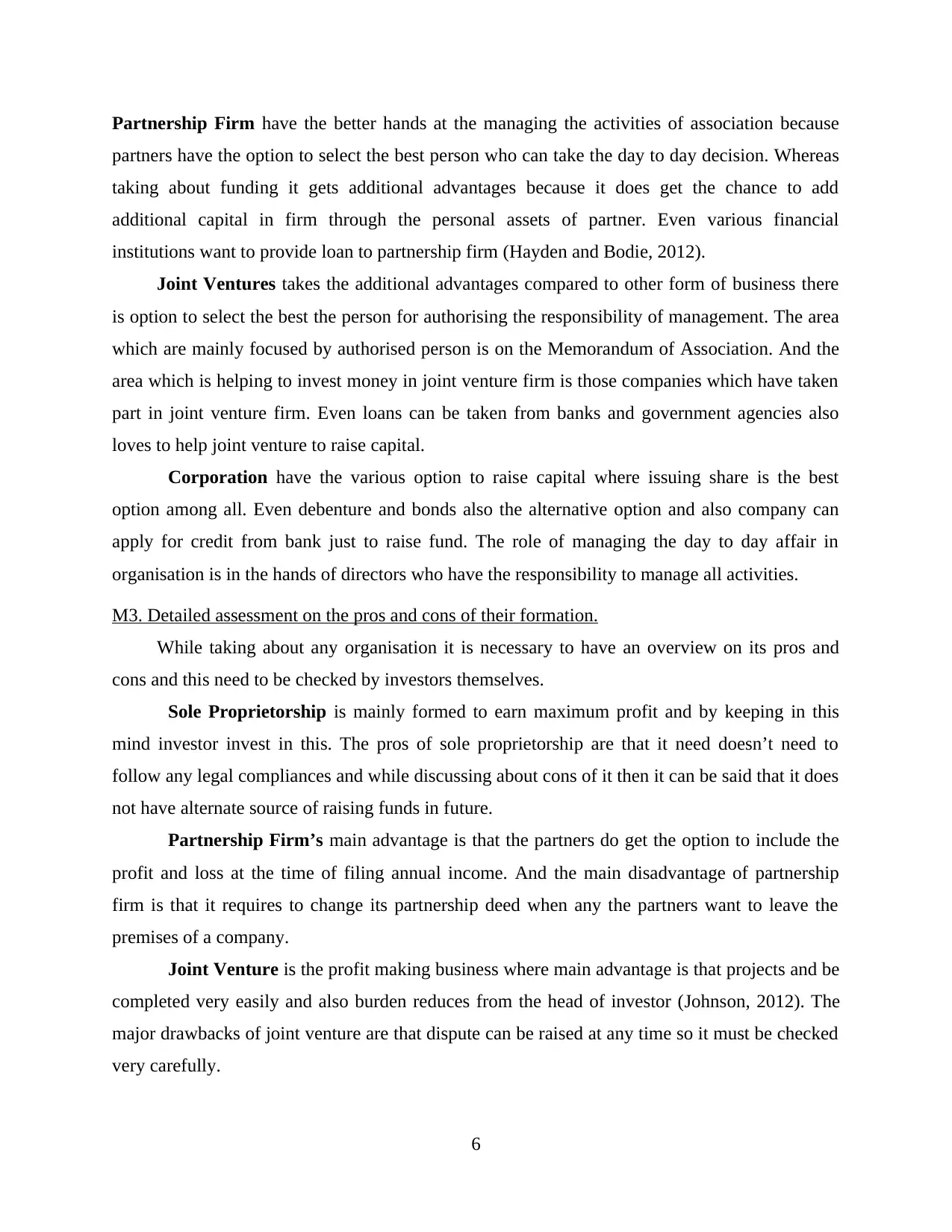
Partnership Firm have the better hands at the managing the activities of association because
partners have the option to select the best person who can take the day to day decision. Whereas
taking about funding it gets additional advantages because it does get the chance to add
additional capital in firm through the personal assets of partner. Even various financial
institutions want to provide loan to partnership firm (Hayden and Bodie, 2012).
Joint Ventures takes the additional advantages compared to other form of business there
is option to select the best the person for authorising the responsibility of management. The area
which are mainly focused by authorised person is on the Memorandum of Association. And the
area which is helping to invest money in joint venture firm is those companies which have taken
part in joint venture firm. Even loans can be taken from banks and government agencies also
loves to help joint venture to raise capital.
Corporation have the various option to raise capital where issuing share is the best
option among all. Even debenture and bonds also the alternative option and also company can
apply for credit from bank just to raise fund. The role of managing the day to day affair in
organisation is in the hands of directors who have the responsibility to manage all activities.
M3. Detailed assessment on the pros and cons of their formation.
While taking about any organisation it is necessary to have an overview on its pros and
cons and this need to be checked by investors themselves.
Sole Proprietorship is mainly formed to earn maximum profit and by keeping in this
mind investor invest in this. The pros of sole proprietorship are that it need doesn’t need to
follow any legal compliances and while discussing about cons of it then it can be said that it does
not have alternate source of raising funds in future.
Partnership Firm’s main advantage is that the partners do get the option to include the
profit and loss at the time of filing annual income. And the main disadvantage of partnership
firm is that it requires to change its partnership deed when any the partners want to leave the
premises of a company.
Joint Venture is the profit making business where main advantage is that projects and be
completed very easily and also burden reduces from the head of investor (Johnson, 2012). The
major drawbacks of joint venture are that dispute can be raised at any time so it must be checked
very carefully.
6
partners have the option to select the best person who can take the day to day decision. Whereas
taking about funding it gets additional advantages because it does get the chance to add
additional capital in firm through the personal assets of partner. Even various financial
institutions want to provide loan to partnership firm (Hayden and Bodie, 2012).
Joint Ventures takes the additional advantages compared to other form of business there
is option to select the best the person for authorising the responsibility of management. The area
which are mainly focused by authorised person is on the Memorandum of Association. And the
area which is helping to invest money in joint venture firm is those companies which have taken
part in joint venture firm. Even loans can be taken from banks and government agencies also
loves to help joint venture to raise capital.
Corporation have the various option to raise capital where issuing share is the best
option among all. Even debenture and bonds also the alternative option and also company can
apply for credit from bank just to raise fund. The role of managing the day to day affair in
organisation is in the hands of directors who have the responsibility to manage all activities.
M3. Detailed assessment on the pros and cons of their formation.
While taking about any organisation it is necessary to have an overview on its pros and
cons and this need to be checked by investors themselves.
Sole Proprietorship is mainly formed to earn maximum profit and by keeping in this
mind investor invest in this. The pros of sole proprietorship are that it need doesn’t need to
follow any legal compliances and while discussing about cons of it then it can be said that it does
not have alternate source of raising funds in future.
Partnership Firm’s main advantage is that the partners do get the option to include the
profit and loss at the time of filing annual income. And the main disadvantage of partnership
firm is that it requires to change its partnership deed when any the partners want to leave the
premises of a company.
Joint Venture is the profit making business where main advantage is that projects and be
completed very easily and also burden reduces from the head of investor (Johnson, 2012). The
major drawbacks of joint venture are that dispute can be raised at any time so it must be checked
very carefully.
6
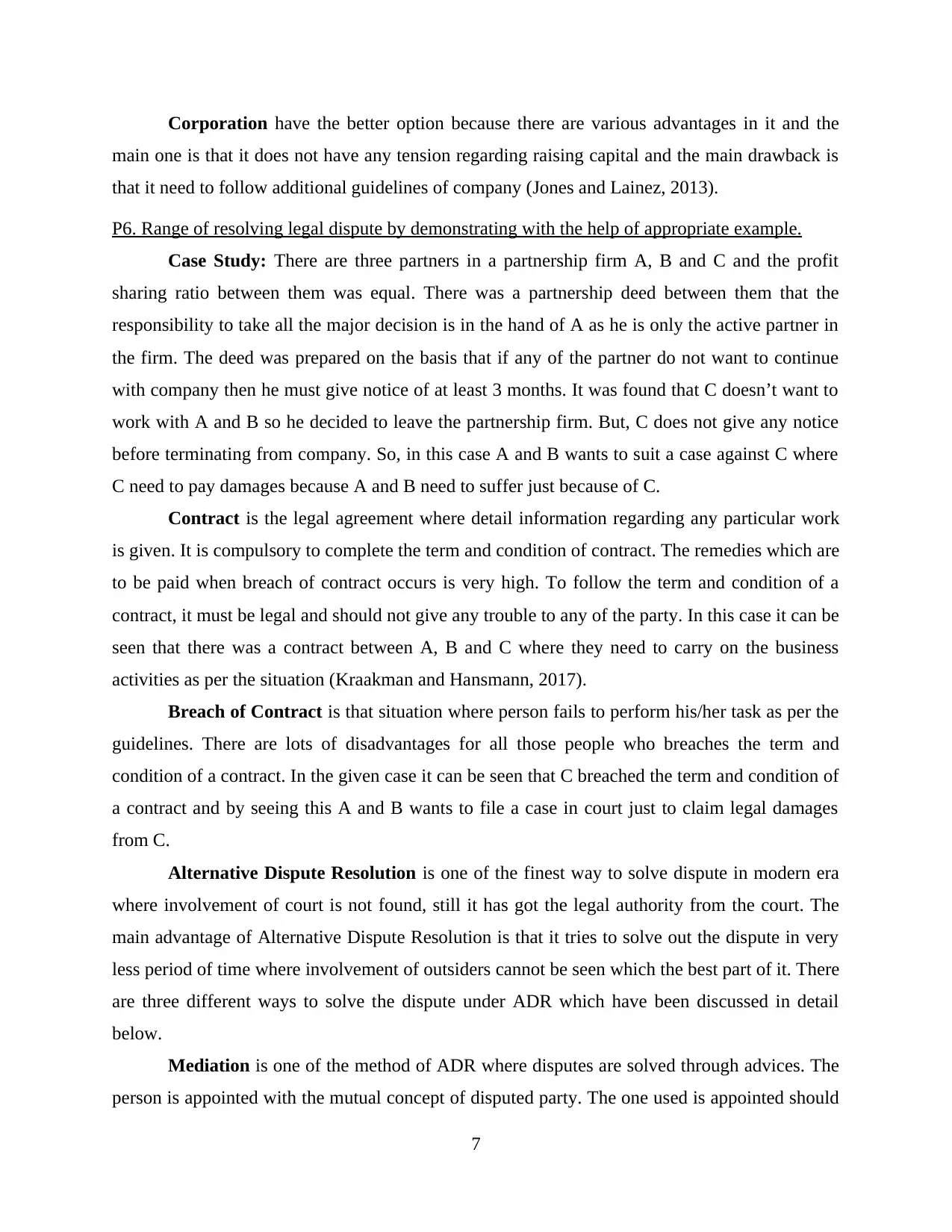
Corporation have the better option because there are various advantages in it and the
main one is that it does not have any tension regarding raising capital and the main drawback is
that it need to follow additional guidelines of company (Jones and Lainez, 2013).
P6. Range of resolving legal dispute by demonstrating with the help of appropriate example.
Case Study: There are three partners in a partnership firm A, B and C and the profit
sharing ratio between them was equal. There was a partnership deed between them that the
responsibility to take all the major decision is in the hand of A as he is only the active partner in
the firm. The deed was prepared on the basis that if any of the partner do not want to continue
with company then he must give notice of at least 3 months. It was found that C doesn’t want to
work with A and B so he decided to leave the partnership firm. But, C does not give any notice
before terminating from company. So, in this case A and B wants to suit a case against C where
C need to pay damages because A and B need to suffer just because of C.
Contract is the legal agreement where detail information regarding any particular work
is given. It is compulsory to complete the term and condition of contract. The remedies which are
to be paid when breach of contract occurs is very high. To follow the term and condition of a
contract, it must be legal and should not give any trouble to any of the party. In this case it can be
seen that there was a contract between A, B and C where they need to carry on the business
activities as per the situation (Kraakman and Hansmann, 2017).
Breach of Contract is that situation where person fails to perform his/her task as per the
guidelines. There are lots of disadvantages for all those people who breaches the term and
condition of a contract. In the given case it can be seen that C breached the term and condition of
a contract and by seeing this A and B wants to file a case in court just to claim legal damages
from C.
Alternative Dispute Resolution is one of the finest way to solve dispute in modern era
where involvement of court is not found, still it has got the legal authority from the court. The
main advantage of Alternative Dispute Resolution is that it tries to solve out the dispute in very
less period of time where involvement of outsiders cannot be seen which the best part of it. There
are three different ways to solve the dispute under ADR which have been discussed in detail
below.
Mediation is one of the method of ADR where disputes are solved through advices. The
person is appointed with the mutual concept of disputed party. The one used is appointed should
7
main one is that it does not have any tension regarding raising capital and the main drawback is
that it need to follow additional guidelines of company (Jones and Lainez, 2013).
P6. Range of resolving legal dispute by demonstrating with the help of appropriate example.
Case Study: There are three partners in a partnership firm A, B and C and the profit
sharing ratio between them was equal. There was a partnership deed between them that the
responsibility to take all the major decision is in the hand of A as he is only the active partner in
the firm. The deed was prepared on the basis that if any of the partner do not want to continue
with company then he must give notice of at least 3 months. It was found that C doesn’t want to
work with A and B so he decided to leave the partnership firm. But, C does not give any notice
before terminating from company. So, in this case A and B wants to suit a case against C where
C need to pay damages because A and B need to suffer just because of C.
Contract is the legal agreement where detail information regarding any particular work
is given. It is compulsory to complete the term and condition of contract. The remedies which are
to be paid when breach of contract occurs is very high. To follow the term and condition of a
contract, it must be legal and should not give any trouble to any of the party. In this case it can be
seen that there was a contract between A, B and C where they need to carry on the business
activities as per the situation (Kraakman and Hansmann, 2017).
Breach of Contract is that situation where person fails to perform his/her task as per the
guidelines. There are lots of disadvantages for all those people who breaches the term and
condition of a contract. In the given case it can be seen that C breached the term and condition of
a contract and by seeing this A and B wants to file a case in court just to claim legal damages
from C.
Alternative Dispute Resolution is one of the finest way to solve dispute in modern era
where involvement of court is not found, still it has got the legal authority from the court. The
main advantage of Alternative Dispute Resolution is that it tries to solve out the dispute in very
less period of time where involvement of outsiders cannot be seen which the best part of it. There
are three different ways to solve the dispute under ADR which have been discussed in detail
below.
Mediation is one of the method of ADR where disputes are solved through advices. The
person is appointed with the mutual concept of disputed party. The one used is appointed should
7
⊘ This is a preview!⊘
Do you want full access?
Subscribe today to unlock all pages.

Trusted by 1+ million students worldwide
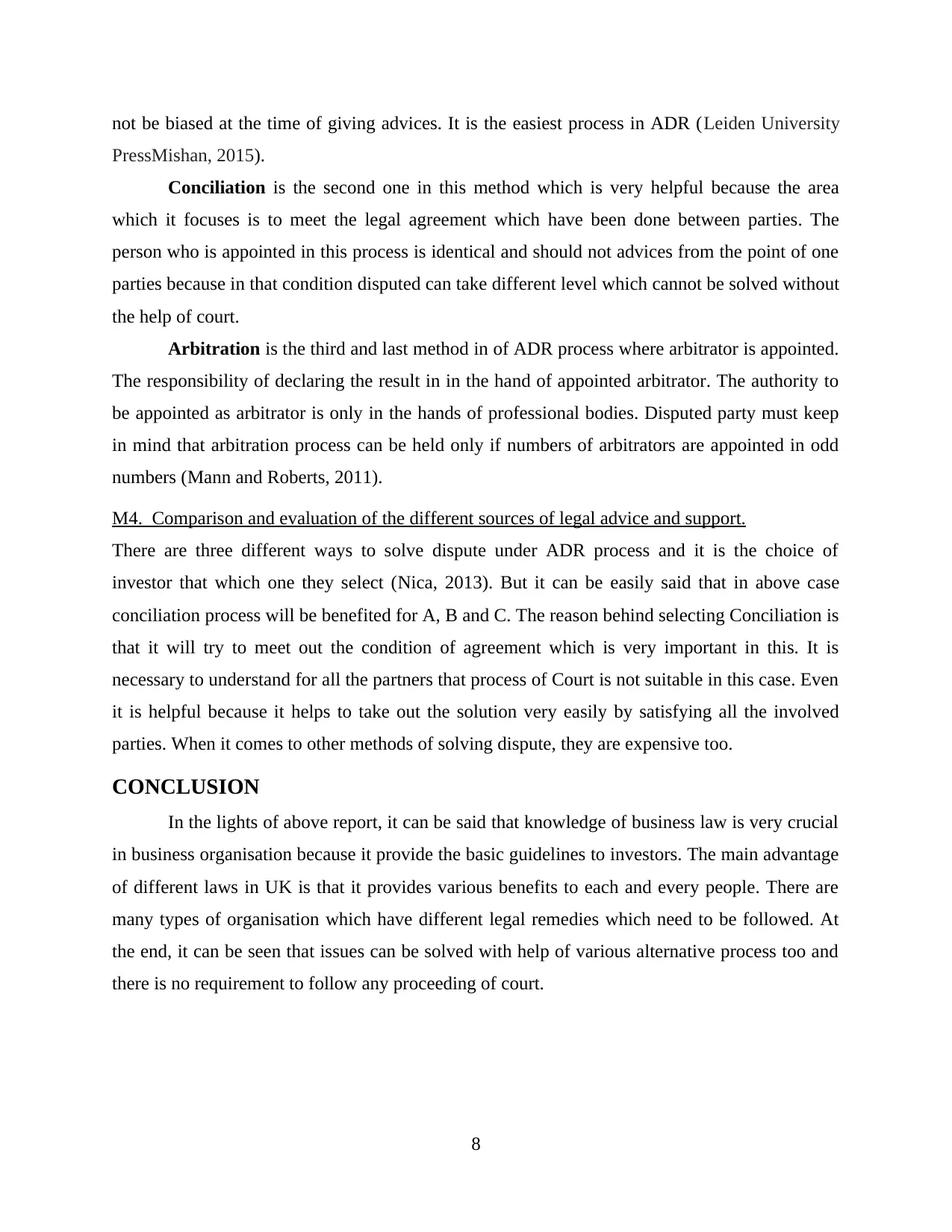
not be biased at the time of giving advices. It is the easiest process in ADR (Leiden University
PressMishan, 2015).
Conciliation is the second one in this method which is very helpful because the area
which it focuses is to meet the legal agreement which have been done between parties. The
person who is appointed in this process is identical and should not advices from the point of one
parties because in that condition disputed can take different level which cannot be solved without
the help of court.
Arbitration is the third and last method in of ADR process where arbitrator is appointed.
The responsibility of declaring the result in in the hand of appointed arbitrator. The authority to
be appointed as arbitrator is only in the hands of professional bodies. Disputed party must keep
in mind that arbitration process can be held only if numbers of arbitrators are appointed in odd
numbers (Mann and Roberts, 2011).
M4. Comparison and evaluation of the different sources of legal advice and support.
There are three different ways to solve dispute under ADR process and it is the choice of
investor that which one they select (Nica, 2013). But it can be easily said that in above case
conciliation process will be benefited for A, B and C. The reason behind selecting Conciliation is
that it will try to meet out the condition of agreement which is very important in this. It is
necessary to understand for all the partners that process of Court is not suitable in this case. Even
it is helpful because it helps to take out the solution very easily by satisfying all the involved
parties. When it comes to other methods of solving dispute, they are expensive too.
CONCLUSION
In the lights of above report, it can be said that knowledge of business law is very crucial
in business organisation because it provide the basic guidelines to investors. The main advantage
of different laws in UK is that it provides various benefits to each and every people. There are
many types of organisation which have different legal remedies which need to be followed. At
the end, it can be seen that issues can be solved with help of various alternative process too and
there is no requirement to follow any proceeding of court.
8
PressMishan, 2015).
Conciliation is the second one in this method which is very helpful because the area
which it focuses is to meet the legal agreement which have been done between parties. The
person who is appointed in this process is identical and should not advices from the point of one
parties because in that condition disputed can take different level which cannot be solved without
the help of court.
Arbitration is the third and last method in of ADR process where arbitrator is appointed.
The responsibility of declaring the result in in the hand of appointed arbitrator. The authority to
be appointed as arbitrator is only in the hands of professional bodies. Disputed party must keep
in mind that arbitration process can be held only if numbers of arbitrators are appointed in odd
numbers (Mann and Roberts, 2011).
M4. Comparison and evaluation of the different sources of legal advice and support.
There are three different ways to solve dispute under ADR process and it is the choice of
investor that which one they select (Nica, 2013). But it can be easily said that in above case
conciliation process will be benefited for A, B and C. The reason behind selecting Conciliation is
that it will try to meet out the condition of agreement which is very important in this. It is
necessary to understand for all the partners that process of Court is not suitable in this case. Even
it is helpful because it helps to take out the solution very easily by satisfying all the involved
parties. When it comes to other methods of solving dispute, they are expensive too.
CONCLUSION
In the lights of above report, it can be said that knowledge of business law is very crucial
in business organisation because it provide the basic guidelines to investors. The main advantage
of different laws in UK is that it provides various benefits to each and every people. There are
many types of organisation which have different legal remedies which need to be followed. At
the end, it can be seen that issues can be solved with help of various alternative process too and
there is no requirement to follow any proceeding of court.
8
Paraphrase This Document
Need a fresh take? Get an instant paraphrase of this document with our AI Paraphraser
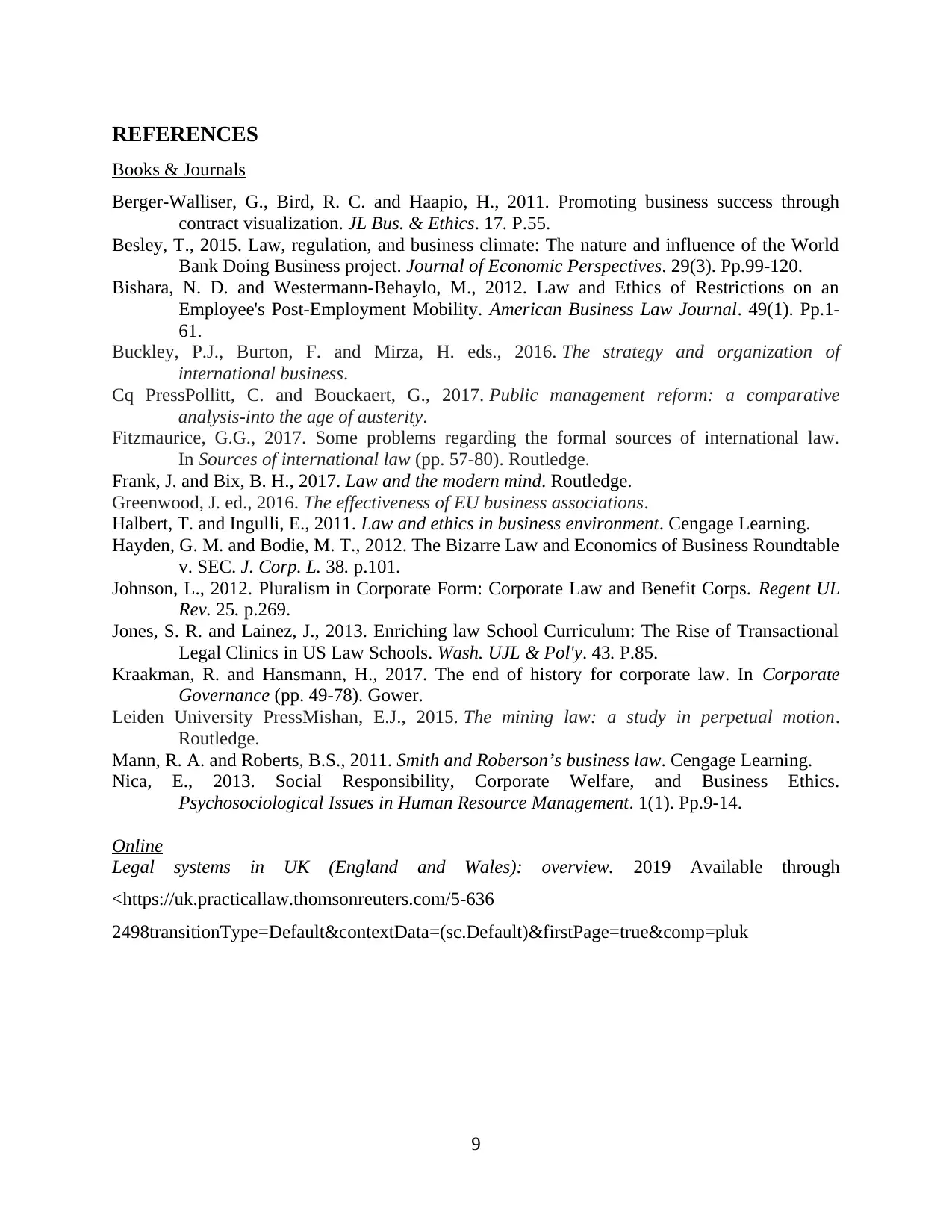
REFERENCES
Books & Journals
Berger-Walliser, G., Bird, R. C. and Haapio, H., 2011. Promoting business success through
contract visualization. JL Bus. & Ethics. 17. P.55.
Besley, T., 2015. Law, regulation, and business climate: The nature and influence of the World
Bank Doing Business project. Journal of Economic Perspectives. 29(3). Pp.99-120.
Bishara, N. D. and Westermann‐Behaylo, M., 2012. Law and Ethics of Restrictions on an
Employee's Post‐Employment Mobility. American Business Law Journal. 49(1). Pp.1-
61.
Buckley, P.J., Burton, F. and Mirza, H. eds., 2016. The strategy and organization of
international business.
Cq PressPollitt, C. and Bouckaert, G., 2017. Public management reform: a comparative
analysis-into the age of austerity.
Fitzmaurice, G.G., 2017. Some problems regarding the formal sources of international law.
In Sources of international law (pp. 57-80). Routledge.
Frank, J. and Bix, B. H., 2017. Law and the modern mind. Routledge.
Greenwood, J. ed., 2016. The effectiveness of EU business associations.
Halbert, T. and Ingulli, E., 2011. Law and ethics in business environment. Cengage Learning.
Hayden, G. M. and Bodie, M. T., 2012. The Bizarre Law and Economics of Business Roundtable
v. SEC. J. Corp. L. 38. p.101.
Johnson, L., 2012. Pluralism in Corporate Form: Corporate Law and Benefit Corps. Regent UL
Rev. 25. p.269.
Jones, S. R. and Lainez, J., 2013. Enriching law School Curriculum: The Rise of Transactional
Legal Clinics in US Law Schools. Wash. UJL & Pol'y. 43. P.85.
Kraakman, R. and Hansmann, H., 2017. The end of history for corporate law. In Corporate
Governance (pp. 49-78). Gower.
Leiden University PressMishan, E.J., 2015. The mining law: a study in perpetual motion.
Routledge.
Mann, R. A. and Roberts, B.S., 2011. Smith and Roberson’s business law. Cengage Learning.
Nica, E., 2013. Social Responsibility, Corporate Welfare, and Business Ethics.
Psychosociological Issues in Human Resource Management. 1(1). Pp.9-14.
Online
Legal systems in UK (England and Wales): overview. 2019 Available through
<https://uk.practicallaw.thomsonreuters.com/5-636
2498transitionType=Default&contextData=(sc.Default)&firstPage=true&comp=pluk
9
Books & Journals
Berger-Walliser, G., Bird, R. C. and Haapio, H., 2011. Promoting business success through
contract visualization. JL Bus. & Ethics. 17. P.55.
Besley, T., 2015. Law, regulation, and business climate: The nature and influence of the World
Bank Doing Business project. Journal of Economic Perspectives. 29(3). Pp.99-120.
Bishara, N. D. and Westermann‐Behaylo, M., 2012. Law and Ethics of Restrictions on an
Employee's Post‐Employment Mobility. American Business Law Journal. 49(1). Pp.1-
61.
Buckley, P.J., Burton, F. and Mirza, H. eds., 2016. The strategy and organization of
international business.
Cq PressPollitt, C. and Bouckaert, G., 2017. Public management reform: a comparative
analysis-into the age of austerity.
Fitzmaurice, G.G., 2017. Some problems regarding the formal sources of international law.
In Sources of international law (pp. 57-80). Routledge.
Frank, J. and Bix, B. H., 2017. Law and the modern mind. Routledge.
Greenwood, J. ed., 2016. The effectiveness of EU business associations.
Halbert, T. and Ingulli, E., 2011. Law and ethics in business environment. Cengage Learning.
Hayden, G. M. and Bodie, M. T., 2012. The Bizarre Law and Economics of Business Roundtable
v. SEC. J. Corp. L. 38. p.101.
Johnson, L., 2012. Pluralism in Corporate Form: Corporate Law and Benefit Corps. Regent UL
Rev. 25. p.269.
Jones, S. R. and Lainez, J., 2013. Enriching law School Curriculum: The Rise of Transactional
Legal Clinics in US Law Schools. Wash. UJL & Pol'y. 43. P.85.
Kraakman, R. and Hansmann, H., 2017. The end of history for corporate law. In Corporate
Governance (pp. 49-78). Gower.
Leiden University PressMishan, E.J., 2015. The mining law: a study in perpetual motion.
Routledge.
Mann, R. A. and Roberts, B.S., 2011. Smith and Roberson’s business law. Cengage Learning.
Nica, E., 2013. Social Responsibility, Corporate Welfare, and Business Ethics.
Psychosociological Issues in Human Resource Management. 1(1). Pp.9-14.
Online
Legal systems in UK (England and Wales): overview. 2019 Available through
<https://uk.practicallaw.thomsonreuters.com/5-636
2498transitionType=Default&contextData=(sc.Default)&firstPage=true&comp=pluk
9
1 out of 11
Related Documents
Your All-in-One AI-Powered Toolkit for Academic Success.
+13062052269
info@desklib.com
Available 24*7 on WhatsApp / Email
![[object Object]](/_next/static/media/star-bottom.7253800d.svg)
Unlock your academic potential
Copyright © 2020–2025 A2Z Services. All Rights Reserved. Developed and managed by ZUCOL.





